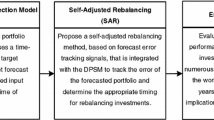Abstract
There are several decisions in investment management process. Security selection is the most time-consuming stage. Tatical allocation is in order to take advantage of market opportunities based on short-term prediction (Amenc and Le Sourd in Portfolio theory and performance analysis. Wiley, 2003). Although it is difficult to keep track of the fluctuations of volatile financial markets, the capacity of artificial intelligence to perform spatial search and obtain feasible solutions has led to its recent widespread adoption in the resolution of financial problems. Classifier systems possess a dynamic learning mechanism, they can be used to constantly explore environmental conditions, and immediately provide appropriate decisions via self-aware learning. This study consequently employs a classifier system in conjunction with real number encoding to investigate how to obtain optimal stock portfolio based on investor adjustment cycle. We examine the constituents of the TSEC Taiwan 50 Index taking moving average (MA), stochastic indicators (KD), moving average convergence divergence (MACD), relative strength index (RSI) and Williams %R (WMS %R) as input factors, adopting investor-determined adjustment cycle to allocate capital, and then constructing stock portfolio. We have conducted empirical testing using weekly and monthly adjustment cycle; the results revealed that this study’s decision-making assistance model yields average annual interest rate of 49.35%, which is significantly better than the −6.59% of a random purchase model. This research indicates that a classifier system can effectively monitor market fluctuations and help investors obtain relatively optimal returns. The assistance model proposed in this study thus can provide really helpful decision-making information to investors.
Similar content being viewed by others
References
Amenc N, Le Sourd V (2003) Portfolio theory and performance analysis. Wiley, London
Arshanapalli B, Coggin TD, Nelson W (2001) Is fixed-weight asset allocation really better?. J Portf Manag 27(3):27–38
Barry AM, Holmes J, Llora X (2004) Data Mining using Learning Classifier Systems. Foundations of Learning Classifier Systems. Springer, Berlin
Beltrametti L, Fiorentini R, Marengo L, Ramborini (1997) A learning-to-forecast experiment on the foreign exchange market with a classifier system. J Econ Dyn Control l.21(8):1543
Blume L, Easley D, MO’Hara (1994) Market statistics and technical analysis: the role of volume. J Finance 49(1):153
Butz MV, Wilson SW (2002) An algorithmic description of XCS. Soft computing-A fusion of foundation, methodologies and applications. Springer, Berlin
Carse B, Fogarty TC, Munro A (1996) Evolving fuzzy rule based controllers using genetic algorithms. Fuzzy Sets Syst 80:273–294
Chan MC, Wong CC, Tse WF, Cheung B, Tang G (2002) Artificial intelligence in portfolio management. Lect Notes Comput Sci 2412:403
Gencay R, Stengos T (1988) Moving average rules, volume and the predictability of security returns with feedforward networks. J Forecast 17:401–414
Hensel CR, Ezra DD, Ilkiw JH (1991) The importance of the asset allocation decision. Financ Anal J 47(4):65–72
Holland JH, Reitman JS (1977) Cognitive systems based on adaptive algorithms. ACM SIGART Bull 49
Huang KD, Hsu CC, Huang CS (2002) Knowledge discovery from recurrent neural network for optimal portfolio capital allocation. Sun Yat-Sen Manag Rev 10(4):651–682
Jahnke WW (1997) The asset allocation Hoax. J Financ Plan 10(1): 109–113
Kendall G, Su Y (2005) A particle swarm optimization approach in the construction of optimal risky portfolios. In: Proceeding of artificial intelligence and applications
Liao PY, Chen JS (2001) Dynamic trading strategy learning model using learning classifier systems. Proc 2001 Congr Evolut Comput l.2: 783
Loiacono D (2004) Evolving rules with XCSF: analysis of generalization and performance. Master dissertation, Politecnico di Milano, Italy
Mark, et al (1991) Using neural networks in market analysis. Techn Anal Stocks Commod 9:18–21
Michaud R (2002) An introduction to resampled efficiency. New Frontier Advisors, Boston
Michaud R (2004) Why mean–variance optimization isn’t useful for investment management. New Frontier Advisors, Boston
Oberuc RE (2003) Dynamic portfolio theory and management: using active asset allocation to improve profits and reduce risk. McGraw-Hill, New York
Pawley MG (2005) Resampled mean–variance optimization and the dynamic nature of markets. In: Proceedings of the biennial 2005 conference of the economic society of South
Pruit SW, White RE (1988) The CRISMA trading system: who says technical analysis can’ beat the market? J Portf Manag Spring: 55–58
Schulenburg S, Ross P (2002) Explorations in LCS models of stock trading. Lect Notes Artif Intell 2321:150–179
Soros G (1994) The Alchemy of finance: reading the mind of the market. Wiley, London
Venugopal MS, Subramanian S, Rao US (2004) Usefulness of genetic algorithm model for dynamic portfolio selection. J Financ Manag Anal 17(1):45–53
Wilson SW (1995) Classifier fitness based on accuracy. Evolut Comput 3(2)
Wilson SW (2000) Get real! XCS with continuous-valued inputs. Lect Notes Comput Sci 1813:209–219
Author information
Authors and Affiliations
Corresponding author
Rights and permissions
About this article
Cite this article
Chen, MC., Lin, CL. & Chen, AP. Constructing a dynamic stock portfolio decision-making assistance model: using the Taiwan 50 Index constituents as an example. Soft Comput 11, 1149–1156 (2007). https://doi.org/10.1007/s00500-007-0158-y
Published:
Issue Date:
DOI: https://doi.org/10.1007/s00500-007-0158-y




